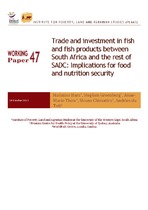| dc.description.abstract | This paper looks at the dynamics of intra-regional trade and investment in fish and fish
products between South Africa and the rest of the Southern Africa Development Community
(SADC) region, and the implications of this trade for food and nutrition security. It is based on
key informant interviews with people in the food industry in South Africa and Africa regional
economic bodies. Imports and exports of fish in South Africa are driven by import substitution,
shortfalls in local production, and meeting growing local and regional demand. Most South
African fish and food processors prefer to export, rather than establish plants in other African
countries, mainly due to factors of economic efficiency and the challenges of doing business in
these countries. Currently, however, increasing volumes of fish are being imported into South
Africa to meet demand from the African migrant community. While self-sufficiency and food
sovereignty are acknowledged priorities for the Southern Africa Development Community
(SADC), imports to meet local shortfalls and specific demand ought to be acceptable options for
ensuring fish food availability and affordability. The reduction or removal of tariffs, through
regional free trade agreements, promotes increased intra-regional trade. Overall, imports and
exports provide for demand-led exchange of fish between SADC states, which promotes
increased availability and affordability of fish; thereby contributing towards food and nutrition
security. However, despite regional free trade agreements that have stipulated the removal of
both technical and non-technical barriers, most small-scale traders still experience problems in
conducting cross-border trade. The majority of people in both South Africa and the SADC still
rely heavily on the informal sector for conduct business and buying food provisions. This
includes cross-border fish trade, which is dominated by small scale-traders, the majority of
whom are women. The informal sector ensures that food reaches most people in an acceptable
state, form and price. In order to promote and facilitate improved and efficient fish trade
delivery systems and positive benefits for food security and livelihoods, governance of crossborder
trade ought to be based on flexible regulations and improved implementation of these. | en_US |

